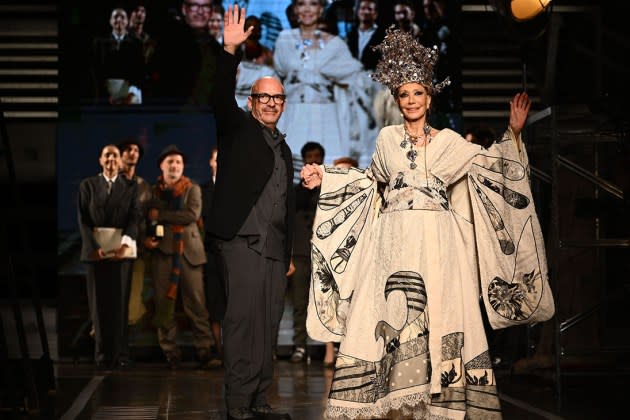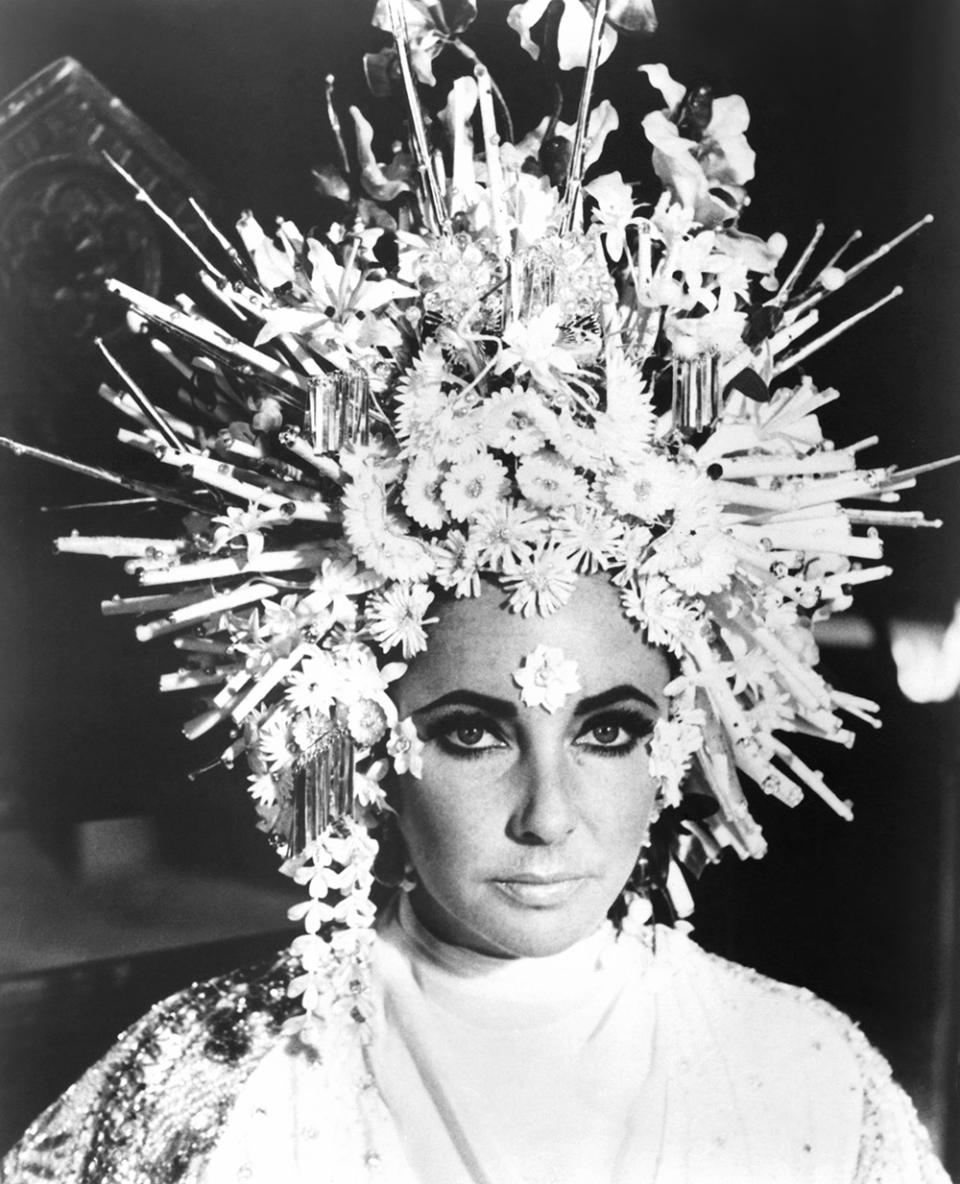Designer Antonio Marras Remakes Elizabeth Taylor’s Boom! On the Runway at Milan Fashion Week
- Oops!Something went wrong.Please try again later.
- Oops!Something went wrong.Please try again later.
- Oops!Something went wrong.Please try again later.
- Oops!Something went wrong.Please try again later.

Antonio Marras’ catwalk transformed into a set where he shot a remake of a 1968 Hollywood movie. During Milan Fashion Week on Sept. 20, the Sardinian fashion designer set up an onstage film studio, with various rooms in which actors, actresses, workers, divas, a production secretary, costume designer, editing secretary, personal assistant, seamstress, director, producer, set coordinator, clapboard operator, sound engineer, extras, models and aspiring actresses took turns in the spotlight. In a flash, the audience found itself catapulted to the end of the golden years of cinema, amid fleeting and rambling kaftans, couture gowns, robes, tailored suits cinched at the waist with masculine styles, duster coats, sheath dresses, and dramatic and divine evening gowns.
The entire show was pulled together to recreate the atmosphere of Joseph Losey’s film Boom!, translated into Italian when it was released as The Cliff of Desires. Tennessee Williams adapted the screenplay from his own stage script, The Milk Train Doesn’t Stop Here Anymore, for the film, starring Elizabeth Taylor and Richard Burton. The movie shoot catapulted its Hollywood stars into the middle of the then-unspoiled, wild country of Alghero, Sardinia.
More from The Hollywood Reporter
Emmy Winner Sheryl Lee Ralph to Receive Inaugural Namesake Trophy at Project Angel Food Awards
Rev. Stephen Pieters, Longtime HIV/AIDS Activist Portrayed in 'The Eyes of Tammy Faye,' Dies at 70
Nicolas Coster, Actor on 'Another World,' 'Santa Barbara' and 'All My Children,' Dies at 89
Fashionable Milan — and a front row that included Olivia Palermo and Larsen Thompson — for 30 minutes thus relived the frenzy of a film set of a major American 1960s production, one of the many films that the studios of the time decided to come and shoot in Italy. Marras, Sardinian to the core but a citizen of the world, found his inspiration for the show when he recently stumbled upon Sergio Naitza’s docu-film The Summer of Joe, Liz and Richard, (L’estate di Joe, Liz e Richard), which reconstructs the making of Boom!. The designer — who cast fashion icon Marisa Berenson for his runway presentation in the role of Elizabeth Taylor — spoke to THR about pulling off his buzzed-about show.
Why did you choose this particular film?
In 1967, Paramount Pictures decided to produce a film directed by Joseph Losey, starring Richard Burton and Elizabeth Taylor. They had to shoot the whole thing on an island in the Mediterranean, and they chose Sardinia. I was six years old but I remember everything. As if by magic, Hollywood lands near my home, on the edge of the sea, in the purest and most unspoiled land in the world. The chosen location was actually Alghero, where two incredible villas were built on the sheer promontory of Capo Caccia. The first villa was knocked down by the wind and they had to build another one right away. How could you not be fascinated?
Was it a big shock for the locals?
Very. The funniest thing was the arrival of these two assistants, who at that time represented the stars par excellence with their many demands, the difficulties of the crew and the extraordinary whims of Elizabeth Taylor. For her, Sardinian grapes were too big, so fresh grapes were brought in every day from Rome. The food didn’t suit her either, thus a plane arrived daily from London bringing everything she needed to eat. Liz had a problem with her hairstyle? They would bring in the famous coiffeur Alexandre de Paris. The dresses were made by a Roman dressmaker, Atelier Tiziano. Hard to imagine, but the man who designed them was Karl Lagerfeld. The film had a really super troubled origin, but it’s full of anecdotes.

The Alghero locals grappling with the jet set.
Imagine what it meant for Alghero in ’67 to have these two crew members walking around the town promenade, stopping at the lowest dive bars for yet another drink. And over time the other dramas, the film, the stars, the happenings, the local extras, the gossip, even kidnapping attempts. The star couple lived on a mega yacht, Kalizma, with dogs, children, cooks, captains and sailors in tow. Liz’s opulent Bulgari jewelry on display, the flow of alcohol, the fights between the two protagonists, the 186-meter cliff at Capo Caccia and the stratospheric white villa overlooking the sea that, agitated by the wind and the waves, kept crashing on the rocks below. The whole experience had taken on an aura of myth.
A film that did not, however, remain in the archives.
It was an international flop. It never went anywhere even though it was translated into 15 languages. It was born from a project made for the theater which, although it had extraordinary actors, was a disaster. The film was released in ‘67 in the midst of revolution, in the midst of protest, out of time. Out of all logic for that time.
How did it come to you?
It later became a film loved and revered by many, talked about in reviews, shown in arthouse cinemas. And thanks to Sergio Naitza’s docu-film.

Did you even like the movie?
It is not a film that impresses you, it’s not exactly a masterpiece. Maybe that’s why it wasn’t a success. Everything is shot inside this mansion, in this time bubble in which she lives. It’s quite a dramatic story, because the main character is waiting for this guy, this angel of death who makes her sick. Liz had the script changed and instead of a young boy she wants Richard Burton instead. More than the movie, I was really fascinated by the creation of the project.
What was the result of this inspiration?
I’ve told you where the genesis of my imagination started. What is my Hollywood ideal? I’ve thought about the diva, the star, the assistant, the producer, the cinematographer, the clapperboard man. I translated this world into clothes that have a lightness, a fluidity, a softness given by the fabrics and volumes and in contrast are really super couture, super tailored constructions that completely transform the silhouette.
Your catwalk became a movie set.
We reconstructed the rooms of the villa with the various sets: the bedroom, the dining room, the car, the objects. There were really two moments of real cinema with lots of machinists, clapboards, microphone operators, producers, directors and an extraordinary international star like Marisa Berenson who lent herself to this game.
You had Marisa Berenson take on the role of Liz Taylor.
I thought that there had to be a diva, a real diva, with a capital D, who is not invented or improvised. A diva who could well interpret a Hollywood Babylon-like world where anything is possible, where a wish is an order, where the unimaginable becomes everyday. Just think of it, write it and shoot it. Marisa Berenson overlooks, wanders, floats. Charm, talent, interpretation, a diva between art and life. She played the part beautifully. She, who in reality is always a very quiet, placid, sweet, wonderful woman, for the show I turned her into a real naughty b****.
Did music also play a key role in recreating the mood of those years?
I chose music that echoes the movies of the time. They are all soundtracks.
What is your relationship with cinema?
I am a lover of cinema, not the making of it, but what you see on the big screen, with the opening of the curtain and the velvet chair. Cinema is the perfect way to travel and isolate yourself from everything else. Audrey Hepburn used to say, “Everything I learned, I learned from the movies.” I say it too, “Everything I learned, I learned from the movies.”
Have you often drawn inspiration from film for your fashion?
I use fashion for storytelling which I learned by going to the cinema. Cinema, an inexhaustible source of stories, dreams, moods, characters, costumes, sets, tales of exceptional existences or extraordinary normality. Cinema is an indispensable companion of life. Even more so for me, because of the work I have found myself doing. I am an omnivore of cinema, having spent my adolescence in Alghero, seeing and reviewing over and over the films that are still part of my life. The characters are family, comparable to relatives, their stories are my stories, their stories I have also experienced. What I am is also the result of what I have seen in the cinema. Intimate and vocal, sharing and becoming an inward moment, as no other form of entertainment can. When the lights go out and the music starts with the opening credits, it is as if we embark on a spaceship that takes you somewhere else and nothing matters anymore.
Best of The Hollywood Reporter

